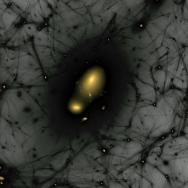Out in space, beyond the familiar confines of Earth’s physics, lie extraordinary phenomena: monstrous black holes, vast clouds that hide the birthplaces of stars, and gigantic clusters of galaxies. Such extreme conditions are hard to study, but they can hold the keys to understanding the evolution of the universe and of our own galaxy.
An international collaboration managed to recreate—for the first time in the laboratory—the growth of magnetic fields at extreme conditions similar to those in the hot plasma that fills clusters of galaxies. The group, co-led by the University of Rochester, the University of Oxford and the University of Chicago, reported their results in an article that appeared March 8 in the Proceedings of the National Academy of Sciences. The rapid amplification they found, which occurs via a phenomenon called the “turbulent dynamo,” exceeds theoretical expectations, and could help explain the origin of the present-day large-scale magnetic fields that are observed in galaxy clusters.
“Understanding how and at what rates magnetic fields are amplified at macroscopic scales in astrophysical turbulence is key for explaining the magnetic fields seen in galaxy clusters, the largest structures in the Universe,” said Archie Bott, postdoctoral research associate at Princeton and lead author of the study.
The experiments were carried out using lasers at the Omega Laser Facility of the Laboratory for Laser Energetics at the University of Rochester, where the team previously demonstrated experimentally the existence of the turbulent dynamo mechanism.
This time, they were able to create conditions similar to the hot, diffuse plasma of the intracluster medium—the space between galaxies in a cluster—in which the turbulent dynamo mechanism is thought to operate. This feat was accomplished with laser beams whose total power is equivalent to that of 10,000 nuclear reactors.
According to scientists’ models, the magnetic fields generated early in the universe are many orders of magnitude smaller than those seen today in galaxy clusters. One possible explanation is that motions in the plasma can pick up these weak “seed” fields and amplify them via stretching, twisting and folding the magnetic fields. The rate at which this amplification happens, the “growth rate,” differs according to how large the plasma motions are. Theory and simulations predict that the growth rate is large at the smallest spatial scales, but far smaller when it comes to the largest turbulent motions.
The experiments, however, demonstrated that this may not be the case: the turbulent dynamo phenomenon—when operating in a realistic plasma—can generate large-scale magnetic fields much more rapidly than theorists had predicted.
“While numerical models and theory predict fast turbulent dynamo amplification at very small scales compared to turbulent motions, it had remained uncertain as to whether the mechanism operates rapidly enough to account for dynamically significantly fields on the largest scales,” Bott said.
The turbulent dynamo mechanism is thought to play a role in producing the magnetic fields seen in a wide variety of astrophysical objects, including planets, stars, galaxies and galaxy clusters, but has previously been studied only through theoretical calculations and numerical simulations.
“This work blazes a path to laboratory investigations of a variety of astrophysical processes mediated by magnetized turbulence,” said Don Lamb, the Robert A. Millikan Distinguished Service Professor Emeritus in Astronomy and Astrophysics at the University of Chicago and principal investigator of the Turbulent Dynamo team National Laser User’s Facility project. “It’s truly exciting to see the scientific results that the ingenuity of this team is making possible.”
The experiments were designed using numerical simulations performed with the FLASH code, a publicly available simulation code that can accurately model laser-driven experiments of laboratory plasmas. FLASH is developed by the Flash Center for Computational Science, which recently moved from the University of Chicago to the University of Rochester.
“The ability to do high-fidelity, predictive modeling with FLASH, and the state-of-the art diagnostic capabilities of the Omega Laser Facility at the Laboratory for Laser Energetics, have put our team in a unique position to decisively advance our understanding of how cosmic magnetic fields come to be,” said Petros Tzeferacos, Director of the Flash Center, Associate Professor at the Department of Physics and Astronomy, and Senior Scientist at the Laboratory for Laser Energetics at the University of Rochester – the simulation lead of the project.
“Our theoretical understanding of the workings of turbulent dynamo has grown continuously for over half a century,” said Gianluca Gregori, Professor of Physics at the Department of Physics of the University of Oxford and the experimental lead of the project. “Our recent TDYNO laser-driven experiments were able to address for the first time how turbulent dynamo evolves in time, enabling us to experimentally measure its actual growth rate.”
The NLUF program of the U.S. Department of Energy’s National Nuclear Security Administration provided the collaboration with access to the Omega Laser Facility and critical funding for the design and execution of the experiments. The FLASH numerical simulations were conducted at the Argonne Leadership Computing Facility with support from the ASCR Leadership Computing Challenge programs of the U.S. Department of Energy Office of Science.
Citation: “Time-resolved turbulent dynamo in a laser plasma.” Bott et al, Proceedings of the National Academy of Sciences, published online March 8, 2021.
Funding: U.S. Department of Energy, the National Science Foundation, the European Research Council, and the Engineering and Physical Sciences Research Council.

